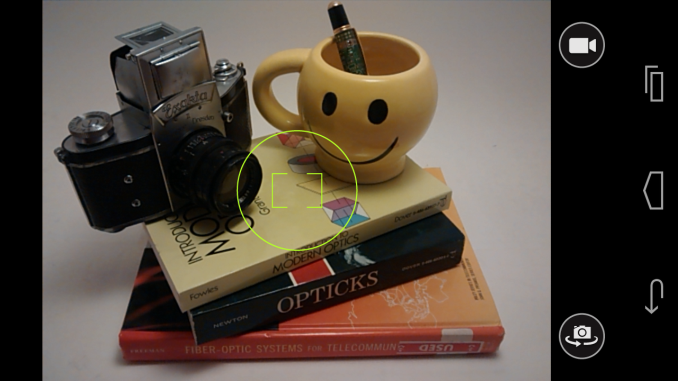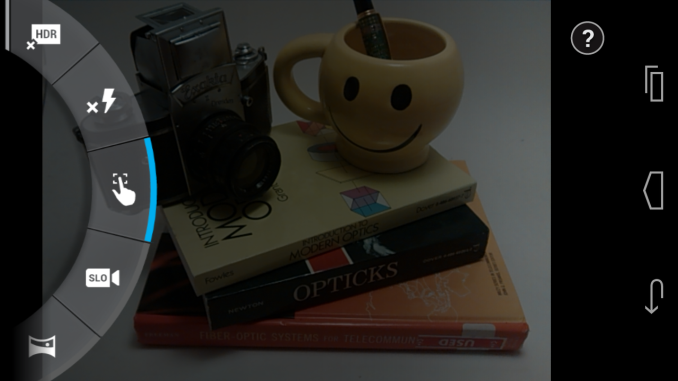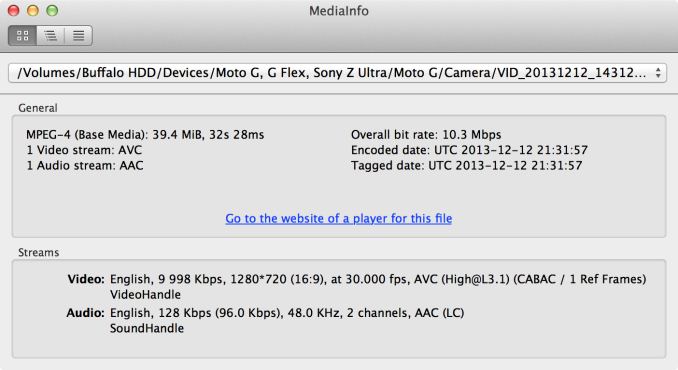Motorola Moto G Review
by Brian Klug on December 18, 2013 2:00 PM EST- Posted in
- Smartphones
- Motorola
- Mobile
- *VA
- Cortex A7
- snapdragon 400
- Moto G
On the camera side the Moto G includes a 5 MP rear facing camera with autofocus and LED flash, on the front it includes a 1.3 MP camera. I did some digging and found that the rear facing camera CMOS is an Aptina AR0543 CMOS. There’s nothing on Aptina’s website about the AR0543, but there is an AR0542 which probably is its predecessor with 1/4 Inch format and 1.4 μm pixels. I suspect this is exactly the form factor of the sensor in Moto G, with some slight improvements, I believe the color filter array is Bayer as well, not RGBW like Moto X. The rear facing camera module has a focal length of 3.5 mm which works out to around a 37mm focal length in 35mm-equivalent units, the system has an F/# of 2.4, which is great for a device of this cost.
On the front is the Aptina MT9M114 1.3 MP, 1/6 Inch with 1.9 µm pixels sensor that we’ve seen a lot of in recent days.
Motorola uses the same camera application as the Moto X, and reflects the most recent UI changes that have rolled out in both OTAs and through the Play Store. The biggest change is a new spot focus and exposure point which can be dragged around the live preview. Motorola calls it manual focus and exposure, in practice it’s really a weighted spot meter and focus point that you can drag around. I’d only call what LG has on the G2 or Nokia bundles as manual focus, but the new camera app is a substantial improvement over the UI as it launched with the Moto X, which didn’t afford any exposure or metering controls (instead taking a scene average), only tap to focus, which ran a full AF search wherever you tapped.
The camera settings menu still is a ring chooser that slides out with a drag from the left side, and has settings for HDR, flash, tap to focus/expose, slow motion video, panorama, location, a new aspect ratio toggle (16:9 and 4:3) and shutter sound. The aspect ratio toggle is what’s new versus the X, since the Moto G has a standard 4:3 aspect ratio sensor and not the 16:9 aspect ratio aspect ratio of the Moto X. By default the Moto G launches with the 16:9 aspect ratio for image capture, cropping off part of the image area, but tapping 4:3 gives you a proper live, full field of view, 4:3 preview. Major kudos to Motorola for giving an aspect-correct live preview. Shot to shot latency is longer than Moto X or other flagships, but not inordinately long or on the order of seconds. I should note that the Moto G does not include the same wrist-flick camera activation gesture as the Moto X.
To evaluate image quality we turn to the usual combination of photos taken at the bench locations, although location 7 wasn’t available, and photo tests in a lightbox with lights on, and off, and of test charts. I also continue to take photos while out and about with devices to get samples in a variety of other conditions.
Moto G still image quality is better than I had suspected. Outdoors in well lit scenes the Moto G is totally capable of delivering good quality shots with good exposure and focus.
My only major criticism is that there’s definitely some off-axis loss of sharpness, the leftmost part of almost every image gets blurry quickly, the right side doesn’t show nearly as much. Alignment tolerances for smartphone optics are a part of module cost, I wouldn’t be surprised to see variance like this. In low light or indoors, the Moto G occasionally struggles to produce images without blur, but that’s a complaint I still levy against some modern flagships. There’s also a bit of light leakage on the Moto G which crops up when outdoors, but nothing crazy. Front facing camera quality is totally par with other flagships I’ve tried, which isn’t surprising.
Camera - Video
On the video side, the Moto G’s interface is, no surprise, just like the Moto X. There’s a video button that immediately starts video capture, successive taps in the image area capture still frames from the live video. Although MSM8x26 supports up to 1080p30 video encode for H.264, Moto G oddly enough captures video at 720p30 in H.264 High profile at 10 Mbps. Audio is stereo thankfully at 128 kbps AAC.
As always I’ve uploaded a copy of the video recorded at the usual place to YouTube and to our servers for you to look at without the additional compression.
Video from the Moto G is well exposed and appears great for being 720p. I would personally miss 1080p, but the Moto G seems great for the resolution it affords. There’s no dropped frames or visible macroblocking, and exposure seems good, again my only desire would be for 1080p resolution.























































120 Comments
View All Comments
ESC2000 - Monday, December 23, 2013 - link
I always appreciate the extensive numbers you guys collect to lend some objectivity to your conclusions rather than offering unsubstantiated impressions and opinions like all other reviews. That said it is interesting to me that people's responses to various displays are so individual-specific. Even though the Samsung phones don't seemto score well other than in black levels of course, I still prefer their displays over most of the other phones on which you gathered data. Overall it looks like the iPhone did the best (although it looks like in some categories - whiteness, grayscale - it regressed from the 5 to the 5s) but I've never liked the displays on iphones. It is hard to evaluate on the 5s because I dislike the color scheme of iOS 7, a strange mixture of pastels and bright red.a1exh - Saturday, December 28, 2013 - link
Nice review. But you missed that the Moto G doesn't have MHL (HDMI out over USB). This feature has been on all my phones for the last few years and is a must have when visiting relatives without a smart TV. I wonder why such an easy feature was omitted?BallGum - Saturday, December 28, 2013 - link
Does anyone expect an update to the Moto G sometime, with the new SnapDragon 410 SoC?Gothmoth - Sunday, December 29, 2013 - link
do you think writing "DELTA" all the time makes you look l33t3?you sound like a cheap wanaabe nerd repeating this "DELTA" over and over.
otherwise the article is nice....
Davidjan - Sunday, January 19, 2014 - link
Really cool! Nice gadget to add Moto G's storage- a tiny MicroSD reader: http://goo.gl/2iJ6gforenlevy - Thursday, January 23, 2014 - link
America ,iphone,nexus updates??? well i have xiaomi mi2s and every week there is ota update,hardware-beast, snapdragon 600 2G ram ,well updates with reach feature but android version change each year .but most kitkat updates already there for monthes, add cloud service includes apps & setting,gallery,logs,sms ect backup ,firewall ,antivirus, ftp server...2 paratiton each time the other update during system on! it is possible and it is hear for 300$ camera i have very nice shoot in darkness using night mode also video in club,i think the near feuture will be chinees company like that,service....updates....every week....
shmotog - Sunday, February 2, 2014 - link
I did my video review on the black flip shell for moto g here http://www.youtube.com/watch?v=ZsnWYpOjDzk&fea...Also here http://www.amazon.co.uk/review/RALAUPNHK9K8U/ref=c...
I also did a review on moto g itself here http://www.youtube.com/watch?v=AP9dGAzfEso
jfelano - Tuesday, February 4, 2014 - link
G stands for GOOGLE duh. Google just bought Motorola.sephirotic - Wednesday, February 5, 2014 - link
No micro SD? "This is a new tendency"? That's ridiculous. This phone is automatically excluded from my next smartphone possible-upgrade lists. No quad core, 720p or "ultra-cheap price"can compensate for that. There has been 50USD phones from 10 years ago that already had micro sd support. This is utterly unacceptable. If you don´t live in US or EU you can´t count on unreliable and limited internet to rely on cloud services. Even so, you can´t install all applications or produce most content relying on remote files. What's the point of a fast processor, good gpu and large screen if you can´t install anything in it or fill it with movies and music? Net surfing and google maps? You don´t need a quad core for that... Only casual users would not see all the drawbacks of being completely limited on local storage. Cloud storage is not "the future", maybe for the casual illiterate user, but for us, power-users and non-US/EU residents, is just a nightmare. I rather expend 30% more on a similar spec phone (even a dual core) with external storage than buying this. I don´t understand how this can appeal to the "masses". Maybe the US "masses", because the rest of the world doesn´t have decent unlimited internet to rely on clound services at all.wolfram74 - Tuesday, February 25, 2014 - link
The camera review does not speaks about speed, time to focus, lag etc. I didn't get the whole information needed about camera.